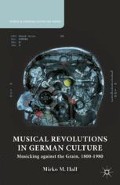Abstract
On June 1, 1980, singer Blixa Bargeld and percussionist N. U. Unruh of the avant-garde band Einstürzende Neubauten (“Collapsing New Buildings”) performed a now-legendary atonal composition in West Berlin’s southwestern district of Friedenau-Schöneberg. Kneeling and bending over inside the claustrophobic crawl space of a pillar supporting the city expressway, these young performers banged, scratched, and pounded against its steel and concrete interior. Bargeld chaotically plucked an untuned electric guitar, which was amplified by a 1960s Telefunken transistor radio, and screamed in German about a postapocalyptic urban wasteland, while Unruh played on a diverse set of percussion instruments ranging from spare metal parts to an old washing machine drum. This 40-minute session of experimental noisescapes, later entitled “Steel Music” (“Stahlmusik”), was recorded on a simple cassette recorder. It was later duplicated and sold as a limited edition cassette tape in Bargeld’s second-hand store, Eisengrau.1
Access this chapter
Tax calculation will be finalised at checkout
Purchases are for personal use only
Preview
Unable to display preview. Download preview PDF.
Notes
Petra Reichensperger, ed., Lieber zu viel als zu wenig. Kunst, Musik, Aktionen zwischen Hedonismus und Nihilismus (1976–1985) (Berlin: Neue Gesellschaft für Bildende Kunst, 2003);
Cyrus Shahan, Punk Rock and German Crisis: Adaptation and Resistance after 1977 (New York: Palgrave Macmillan Press, 2013).
Gershom Scholem, “Walter Benjamin and His Angel,” in On Walter Benjamin: Critical Essays and Recollections, ed. Gary Smith (Cambridge, MA: Massachusetts Institute of Technology Press, 1988), 51.
Blixa Bargeld, Headcleaner: Text für einstürzende Neubauten/Text for Collapsing New Buildings, ed. Maria Zinfert, trans. Matthew Partridge (Berlin: Die Gestalten Verlag, 1997), 73.
Rolf Tiedemann, “Historical Materialism or Political Messianism? An Interpretation of the Theses ‘On the Concept of History,’” in Benjamin: Philosophy, Aesthetics, History, ed. Gary Smith (Chicago: University of Chicago Press, 1989), 202.
Simon Reynolds, Rip It Up and Start Again: Postpunk 1978–1984 (New York: Penguin Books, 2006), 2.
Erhard Schüttpelz, “Akademie der Dilettanten (Back to D.),” in Akademie, ed. Stefan Dillemuth (Köln: Permanent Press, 1995)
Friedrich Kittler, “World-Breath: On Wagner’s Media Technology,” in Opera through Other Eyes, ed. David J. Levin (Stanford: Stanford University Press, 1993), 224.
Richard Norton, Tonality in Western Culture: A Critical and Historical Perspective (University Park: Pennsylvania State University Press, 1984).
Copyright information
© 2014 Mirko M. Hall
About this chapter
Cite this chapter
Hall, M.M. (2014). Blixa Bargeld and Noise. In: Musical Revolutions in German Culture. Studies in European Culture and History. Palgrave Macmillan, New York. https://doi.org/10.1057/9781137449955_5
Download citation
DOI: https://doi.org/10.1057/9781137449955_5
Publisher Name: Palgrave Macmillan, New York
Print ISBN: 978-1-349-49763-8
Online ISBN: 978-1-137-44995-5
eBook Packages: Palgrave Literature CollectionLiterature, Cultural and Media Studies (R0)

